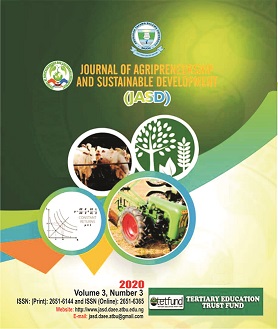IMPACT OF FARM INSTITUTES AND TRAINING CENTERS ON SPINACH PRODUCTION AND LIVELIHOOD OF RURAL DWELLERS IN NIGER STATE, NIGERIA
DOI:
https://doi.org/10.59331/jasd.v3i3.136Keywords:
Farm Institutes, Impact, Livelihood, Production, SpinachAbstract
The study assessed impact of farm institutes and training centers on spinach production and livelihood of rural dwellers in Niger State, Nigeria. A multi-stage sampling technique was used to select 206 of rural dwellers. Data were collected using structured questionnaire and interview scheduled and analyzed using descriptive statistics (percentage, frequency and mean) and Chow test. The result revealed 89.8% of the respondents were males while the mean age of the respondents was 34 years. Also, 83.5% of the respondents were married while 74.7% had secondary education. The result of the output revealed that the Chow F-calculated was 149.87, while F-table value at 10 degree of freedom with sample size of 206 is 1.85 at 5% level. The Chow F-calculated for income was 3.952, while the F-table value at 10 degree of freedom with the sample size of 206 was 1.85 at 5% level of probability. The Chow F-calculated for level of living was 24.24 and F-table value at 10 degree of freedom with sample size of 206 was 1.85 at P≤0.05 level of probability. The major constraints encountered by the respondents were untimely delivery of inputs (100.0%) and cost of equipment (97.1%). It was recommended that provision of inputs should be made available to spinach producers timely and speedily and good seedlings should be provided to farmers by farm institutes and training centers (FITC) in order to enhance their outputs.
Downloads

Downloads
Published
How to Cite
Issue
Section
License
Copyright (c) 2022 Journal of Agripreneurship and Sustainable Development

This work is licensed under a Creative Commons Attribution 4.0 International License.






